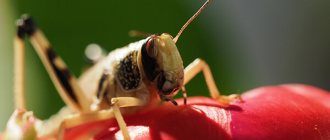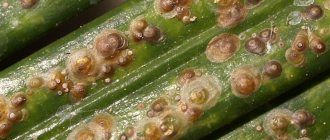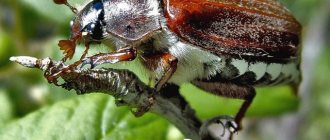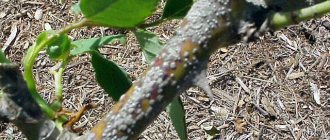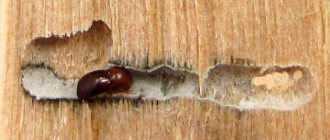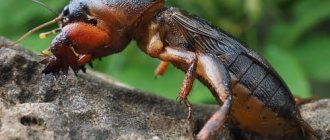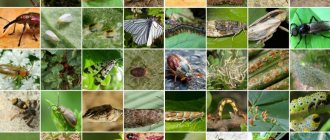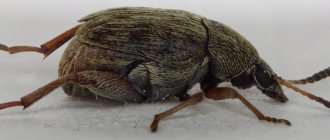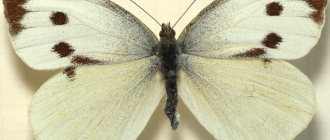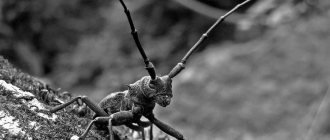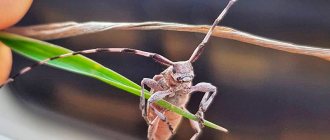The roseate sawfly is an insect that actively parasitizes berry and ornamental crops. It affects rose flowers, most often rose bushes, which is why it got its name. The most harmful are the larvae - these inconspicuous creatures eat succulent foliage with appetite and as a result, after their invasion, only bare twigs remain on the bushes. They can also gnaw through shoots, which is why plants begin to rapidly wither. Is there any salvation from this scourge?
What does the rose sawfly look like?
The roseate sawfly is a fairly large hymenopteran insect 7-10 mm long. There are several varieties of it; gardeners most often encounter the top-down type. The natural habitat of the pest is Europe, Eastern Siberia, North Africa. It has also successfully taken root in North America and Central Asia.
Females can be distinguished from males by their thicker abdomen and the presence of a pointed “tip” - the ovipositor. The chitinous shell of the insect is glossy, orange-black, the wings are thin, almost transparent, shimmering with golden yellow. Two antennae are clearly visible on the head, to which the pest owes its popular nickname “fatwhisker”. From the photo you can see that the descending roseate sawfly slightly resembles a miniature wasp.
Thanks to its bright color, it is easy to spot the roseate sawfly on a bush.
Important! The period of maximum activity of the roseate sawfly is from the last ten days of May to the end of July. The insect prefers dry and sunny weather.
Females are not fertile, laying about 70 eggs per season. They are very small (less than 1 mm), yellowish, as if made of glass. The insect “hides” them under the bark of non-lignified stems (the growth of the current season) - the shoots are deformed, and a “cavity” remains after laying.
After ten days, the eggs hatch into larvae - translucent whitish pseudo-caterpillars about 4 mm long. As they “grow up” through molting, the color changes to brownish, black spots appear along the body and near the head, and limbs are formed.
The larvae crawl in groups throughout the bush, gnawing the stems from the inside and gradually descending to the base of the shoots. There they pupate and overwinter in the ground, in a light beige cocoon made of “spider web”.
Roseate sawfly larvae, distinguished by their gluttony, are predominantly nocturnal.
In the spring, when the temperature reaches about 10 °C, adult individuals emerge from the cocoons in batches. They do not live long and do not cause direct harm to the bushes, but they manage to lay another batch of eggs in 2-3 stages.
Important! Roses can also be attacked by the rising rose sawfly. Outwardly, for a non-specialist, they are no different; the pest can be identified by the characteristics of the damage.
Description
The sawfly beetle, depending on the species, can be from 2 to 32 mm long. The head of sawflies is not separated from the body, like that of a wasp or a bee, for which they are called sessile bellies. Sawfly heads are large, mobile, equipped with well-developed jaws, two large eyes and three simple eyes located in front. Sawfly whiskers are bristly or thread-like, and they have two pairs of transparent, non-folding wings. The females have a sawtooth-shaped ovipositor hidden in their abdomen, with which they damage plants. In males, the place where in females there is an opening for the exit of the ovipositor is covered with a plate.
In early spring, sawflies mate, after which the females lay eggs, making an incision in the tissue of one or another part of the plant for each, after which the female seals the pocket with the egg with secretions, protecting both the egg and part of the plant from rotting.
The sawfly larva, as soon as it emerges from the egg, begins to eat, causing significant damage to plants. In the larval stage, sawfly insects are similar to butterfly caterpillars, however, caterpillars have no more than 5 pairs of legs and six eyes, and sawfly larvae have 6 or 8 pairs of legs and only 2 eyes, which is why beetle larvae are called pseudocaterpillars. Having eaten enough, sawfly caterpillars descend from the tree at the beginning of summer and build cocoons for pupation in the ground from their own excrement, dust and saliva. In mid-summer, the second generation of pests emerges from cocoons, and in one season the sawfly can produce up to 4 generations, which eat foliage from spring to autumn.
- Aphids on cucumbers are not a death sentence: 3 simple ways to fight without chemicals
All sawflies are herbivorous. Each species lives on a specific wild or cultivated plant, damaging it and feeding on its tissues.
What harm does
Infestation of bushes by insects means, at a minimum, late and poor flowering. In most cases, you can’t expect it at all this season - roses are massively losing buds and flower buds on the affected stems.
A rose with darkening and withering shoots noticeably loses its decorative value
Mechanical damage left by the pest on the shoots is a “gateway” for pathogenic fungi. The experience of gardeners shows that infection with pathogenic microflora is almost inevitable.
Bushes attacked by the rose sawfly are greatly weakened. Their cold resistance and overall endurance drops noticeably. It is not a fact that the plant will survive the coming winter. The more demanding a variety is to care for, the higher the likelihood of its death.
Thrips
These pests most prefer fragrant roses with light-colored flowers, but can also cause damage to other plants. Brown or black spots appear on the buds and flowers, the petals look chewed and darkened.
If you rub the flower or look into its core, you can find fast-moving small black insects about 2 mm long. These are thrips - the most difficult pests of roses. As a rule, they appear in hot and dry weather.
Control and prevention measures:
|
Signs of defeat
The most obvious evidence of a pest attack on bushes is the presence of adult individuals on them. It is difficult to notice the larvae of the descending roseate sawfly - they hide in the stems and rarely come out.
The damage left on the stems from egg laying lasts a long time and does not completely “heal”
What symptoms appear on the bushes after insect damage and indicate the presence of roseate sawfly larvae:
- the sudden onset of the plant's withering process when properly cared for;
- unnatural curvatures and thickenings on the stems;
- black cavities inside the shoots if you break or cut them;
- thin, translucent “cobwebs” at the bottom of the bush.
To make sure there are rose sawfly larvae on the bush, you will have to cut several stems
If rose sawfly larvae also feed on leaves, holes appear on them. At first they are very small, more like punctures, but gradually increase in size, only veins remain from the leaf plates. Less commonly, the insect eats leaves from the inside, leaving “passages” like tunnels, feeds on stamens and pistils, and damages rose petals.
Leaves and stems affected by rose sawfly gradually dry out and die.
Category: “Questions and answers”
Question No. 1. How long do sawflies live?
An adult adult lasts only 10 days, but during this time each female lays an average of up to 70 eggs. If you don't fight them, they will destroy the rose garden.
Question No. 2. How long does it take to get rid of the sawfly?
If there are few pests and the treatment is carried out on time, then once is enough. But, it is better not to risk it and carry out additional spraying and preventive work in the fall and spring of next year. You cannot be sure that the insects will not appear again.
Reasons for appearance
The roseate sawfly is a flying insect. It moves freely over fairly long distances in search of food. Wild rose hips can “attract” it to your garden plot, so it is recommended to get rid of its thickets.
The gardener himself can “infect” rose bushes. The most common methods are the use of soil in which the larvae overwinter when replanting, throwing out shoots affected by the roseate sawfly into a compost pit, and “storing” plant debris in an area.
Methods of control using chemicals, taking into account the characteristics of pest development
When the adult caterpillar reaches the ground, pupation occurs, which lasts 14 days.
The cocoon matures with the onset of warm weather. The approximate timing of the appearance of adults is the end of May. Taking into account weather conditions, a more accurate time is the flowering of garden strawberries. At this time, it is important to prevent the caterpillar from ending up in the soil. It is important not only to choose the right protective agent against sawfly and borer, but to apply it in time. To do this, you need to know the reproduction cycles of insects.
The sawfly larva is called a false caterpillar and appears at the end of April. At the beginning of development it is white in color and 4 mm long. After a month, the formed body acquires black spots, and the underside of the abdomen turns yellow.
Young larvae accumulate in groups and, as they mature, spread throughout the bush. As adults, after about a month, they move to the soil to pupate.
At this time, you can deal with them using an environmentally friendly method - collecting them by hand .
The flight continues until July. If during this period you notice a small flying insect, 1 cm in size, black and yellow in color, this means that there is a sawfly in the rose garden and you need to treat the bushes with protective insecticides.
How to deal with rose sawfly on roses
To get rid of sawfly on roses, you can use both folk remedies and insecticides. The method is chosen taking into account the degree of neglect of the problem. The greater the number of pests on the bushes and affected shoots, the higher the likelihood that folk remedies and biological products will not help, and you will have to use “heavy artillery” in the form of chemicals.
Preparations for rose sawfly
When using chemicals against roseate sawfly, you must follow the instructions exactly and use personal protective equipment. Exceeding the dosage of insecticide in solution or more frequent treatments can harm human health, other plantings, and beneficial fauna.
Aktara
A universal systemic insecticide based on thiamethoxam, for many insects, including the roseate sawfly, which is a neurotoxin. Belongs to hazard class III. After treatment, it “impregnates” the plant tissue within 2-3 hours, the effect lasts for two months, regardless of weather conditions.
When using Aktara against roseate sawfly, you need to take into account that this insecticide is toxic to bees
When using Aktara against roseate sawfly, you need to take into account that this insecticide is toxic to bees
Tanrek
Insecticide based on imidacloprid. Roseate sawfly larvae die when feeding on the tissues of treated plants, while adults die when they come into direct contact with the drug solution. The product begins to act on the 3rd day after spraying, the effect lasts for 20 days. Tanrek cannot be combined with other agrochemicals; soap shavings must be added to the solution.
Tanrek can be used to protect roses from rose sawfly not only in the garden, but also at home
Angio
An insecticide, due to the presence of two active substances (cyhalothrin and thiamethoxam), penetrates into the body of the roseate sawfly through the outer chitinous integument and during feeding. Pests die within half an hour after contact due to internal “burns”. One treatment is enough for 20-40 days (depending on the frequency and intensity of precipitation).
Enzhio insecticide cannot be used in water protection zones; plants are deadly to bees within two days after treatment
Fitoverm
A very popular insectoacaricide of biological origin with enteric contact action. The active substance is aversectin-S. When a roseate sawfly enters the body, it deprives it of the ability to feed; after 2-3 days the larvae die. The protective effect lasts up to 20 days.
Fitoverm is not phytotoxic, it can also be used on fruit-bearing garden crops
Bitoxibacillin
A biological product based on a combination of “natural” toxins and bacterial strains. “Saturating” plant tissues, it enters the digestive tract of roseate sawfly larvae and provokes the spread of alkali from the intestines throughout the body, as a result of which the pests die. The product provides protection for approximately 20 days and is toxic to beneficial soil microflora.
Bitoxibacillin against roseate sawfly acts rather slowly and is incompatible with other agrochemicals
Folk remedies for sawfly on roses
Folk remedies are used mainly to prevent rose sawfly attacks on rose bushes. If the pest was not noticed in time and multiplied in numbers, they will not help get rid of it; the gardener will only waste time, aggravating the problem.
How can you treat roses from sawfly:
- Wood ash. Helps get rid of roseate sawfly and any sucking and gnawing pests. It is enough to sprinkle the soil around the tree trunk with ash (about 0.5 liters per plant), and then water the bushes well. The components penetrate into the tissues and juice, making them bitter and “unpalatable” to the roseate sawfly. The effect lasts for 5-7 days. Mustard powder and tobacco dust act similarly.
- Sagebrush. The pungent smell of its infusion helps to repel adult rose sawflies from roses. Fresh leaves and stems are crushed, poured with hot water in a volume of approximately 1:3 and left in a dark, warm place for 3-4 days, periodically vigorously shaking the liquid. The finished infusion is filtered and used for spraying bushes and soil in the tree trunk circle.
- Nightshade. Poison for most caterpillars, including the roseate sawfly. The product is prepared by boiling 1 kg of fresh leaves in 2 liters of water (four hours). The resulting liquid is filtered, water is added (0.8-1 l).
Wood ash not only ensures that roses are “inedible” for the rose sawfly, but also enriches the substrate with potassium, phosphorus, and magnesium
Important! Instead of wormwood, infusions to combat the roseate sawfly can be prepared from other “raw materials”. Any plants with a strong odor will do.
Agrotechnical methods
Proper agricultural technology is the best remedy for the roseate sawfly, allowing you to prevent its attacks on bushes. Proper watering and fertilizing play a very important role in maintaining the endurance and ensuring good immunity of roses. In addition, proper pruning is important. Moist, stale air accumulates in the middle of a thickened bush.
Important! Roses need to be inspected regularly. This will allow you to notice a pest attack at an early stage and take timely measures.
Sanitary pruning for the purpose of thinning the bush is carried out in spring and autumn
Fighting methods
The larvae are nocturnal. It is easier to deal with superficial insects. They can be collected from the plant and then destroyed. But you must be careful; at the slightest touch or if you shake the shoot and disturb them, the larvae curl up and fall to the ground, and there they will be more difficult to find. It is better to collect the larvae in the morning, at which time they are on the surfaces of the leaves. But it’s safer to inspect the entire plant.
Control methods for ascending and descending sawflies are different. Stems affected by larvae will have to be cut off; it is better to do this before the larvae crawl into the ground. The shoots are cut to the base, at the root. The larvae are naturally destroyed. It is good to use insecticides. The most suitable drugs will be contact drugs. Such hidden varieties include Aktara, Mospilan, and Enzhio. For larvae that eat leaves and live on the surface, Decis, Fastak, Karate and other insecticides are very effective.
Most often, to combat sawflies, gardeners use the systemic drug Aktara.
Prevention
It is much easier to prevent the appearance of roseate sawfly than to fight it later. Effective preventive measures:
- Construction or purchase of traps for adult individuals or scaring away the roseate sawfly with any sharp-smelling infusions, planting flowers and herbs with a characteristic aroma next to the flowerbed.
- Annual spraying of roses and tree trunks with solutions of universal insecticides in early spring and late autumn.
- Mandatory renewal of the mulch layer and deep loosening of the soil at the roots in preparation for winter.
- Collection and destruction of all plant debris after flowering and autumn pruning.
Loosening the tree trunk in the fall destroys the shelters in which the roseate sawfly larvae gather to overwinter.
Important! Rose bushes planted in the shade especially need monitoring and prevention against roseate sawfly. The experience of gardeners shows that any pests attack them more often.
Spider mite
This insect harms not only roses, but the mite especially loves these plants. At first, the leaves become covered with small pale yellow spots, over time they lighten or turn yellow, and if severely affected, they dry out and fall off. In advanced cases, a thin cobweb can be seen at the base of the shoots.
If you look closely at a damaged plant, sometimes you can see the pest itself: the underside of the leaf will be strewn with small white grains. This is a mite (only 0.5-1 mm in size), the body of which is colored brown, green, brown or gray.
Most often, roses grown in greenhouses and indoors suffer from spider mites, since this pest becomes most active in dry air.
Control and prevention measures:
|
Adviсe
By following the recommendations of experienced gardeners, you can avoid damage to rose leaves and enjoy their full bloom.
- You can protect your rose garden from the invasion of the hairy Alyonka, the bronze beetle and the alfalfa leaf-cutting bee using a special fine-grained net that needs to be thrown over the bushes.
- The choice of chemicals depends on the capabilities and type of rose leaf pests. Before purchasing products, you must carefully inspect the packaged insecticide, and also look at the date of manufacture and shelf life.
- At the first signs of the presence of pests on roses, complex treatments against parasites should be immediately carried out. After all, some pests begin their reproduction cycle within 3-5 hours after they hit the foliage.
